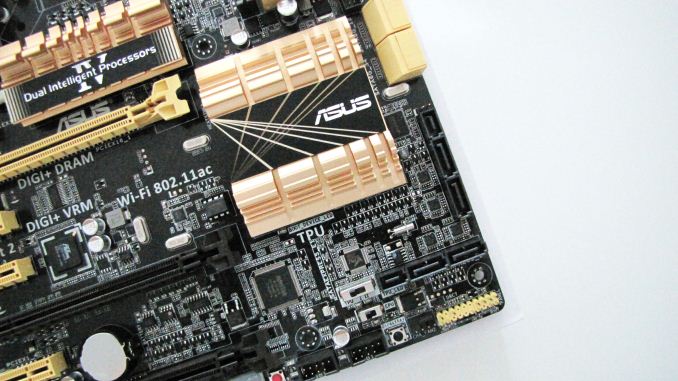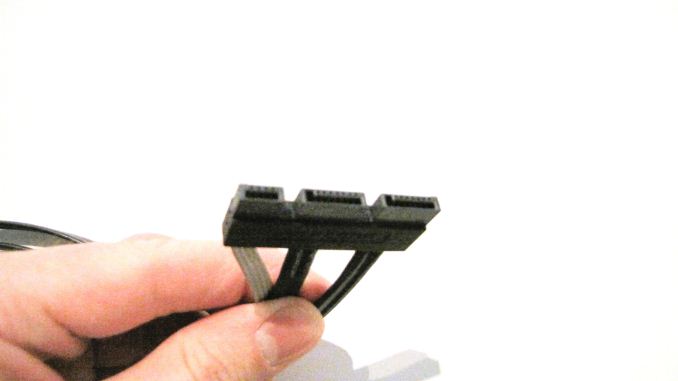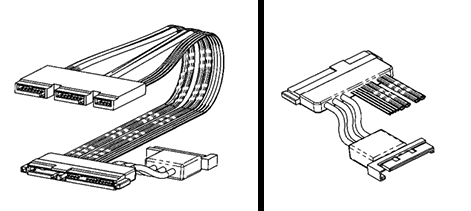Testing SATA Express And Why We Need Faster SSDs
by Kristian Vättö on March 13, 2014 7:00 AM EST- Posted in
- Storage
- SSDs
- Asus
- SATA
- SATA Express
What Is SATA Express?
Officially SATA Express (SATAe from now on) is part of the SATA 3.2 standard. It's not a new command or signaling protocol but merely a specification for a connector that combines both traditional SATA and PCIe signals into one simple connector. As a result SATAe is fully compatible with all existing SATA drives and cables and the only real difference is that the same connector (although not the same SATA cable) can be used with PCIe SSDs.
As SATAe is just a different connector for PCIe, it supports both the PCIe 2.0 and 3.0 standards. I believe most solutions will rely on PCH PCIe lanes for SATAe (like the ASUS board we have), so until Intel upgrades the PCH PCIe to 3.0, SATAe will be limited to ~780MB/s. It's of course possible for motherboard OEMs to route the PCIe for SATAe from the CPU, enabling 3.0 speeds and up to ~1560MB/s of bandwidth, but obviously the PCIe interface of the SSD needs to be 3.0 as well. The SandForce, Marvell, and Samsung designs are all 2.0 but at least OCZ is working on a 3.0 controller that is scheduled for next year.
The board ASUS sent us has two SATAe ports as you can see in the image above. This is a similar port that you should find in a final product once SATAe starts shipping. Notice that the motherboard connector is basically just two SATA ports and a small additional connector—the SATA ports work normally when using a standard SATA cable. It's only when the connector meets the special SATAe cable that PCIe magic starts happening.
ASUS mentioned that the cable is not a final design and may change before retail availability. I suspect we'll see one larger cable instead of three separate ones for esthetic and cable management reasons. As there are no SATAe drives available yet, our cable has the same connector on both ends and the connection to a PCIe drive is provided with the help of a separate SATAe daughterboard. In the final design the other end of the cable will be similar to the current SATA layout (data+power), so it will plug straight into a drive.
That looks like the female part to the SATA connector in your SSD, doesn't it?
Unlike regular PCIe, SATAe does not provide power. This was a surprise for me because I expected SATAe to fully comply with the PCIe spec, which provides up to 25W for x2 and x4 devices. I'm guessing the cable assembly would have become too expensive with the inclusion of power and not all SATA-IO members are happy even with the current SATAe pricing (about $1 in bulk per cable compared to $0.30 for normal SATA cables). As a result, SATAe drives will still source their power straight from the power supply. The SATAe connector is already quite large (about the same size as SATA data + power), so instead of a separate power connector we'll likely see something that looks like this:
In other words, the SATAe cable has a power input, which can be either 15-pin SATA or molex depending on the vendor. The above is just SATA-IO's example/suggestion—they haven't actually made any standard for the power implementation and hence we may see some creative workarounds from OEMs.















131 Comments
View All Comments
willis936 - Friday, March 14, 2014 - link
A 4.5GHz 4770k doesn't render my video, crunch my matlab, and host my minecraft at arbitrarily amazingly fast speeds, but it's a big step up from a Q6600 :pMrBungle123 - Friday, March 14, 2014 - link
That cable looks horrible, I'd rather them just move SSD's to a card.TEAMSWITCHER - Friday, March 14, 2014 - link
Second That! Hardware makers need to abandon SATA Express and start working on new motherboard form factors that would allow for attaching the flash drives directly to the motherboard. SATA Express is another compromised design-by-committee. Just what the struggling PC industry needs right now! Jeepers!!!iwod - Friday, March 14, 2014 - link
The future is Mobile. Where Laptop already overtook Desktop in numbers. So why another chunky ugly old hack for SSD? Has Apple not taught them a lesson where Design matters?And the speed, It is just too slow. We should at least be at 16Gbps, and since any of these standard aren't even coming out fast enough i would have expected the interface to leap to 32Gbps. Plenty of headroom for SSD Controller to improve and work on. And Intel isn't even bundling enough PCIe Lanes direct from CPU.
Why cant we build something that is a little future proof?
willis936 - Friday, March 14, 2014 - link
Cost matters. The first thing they'll tell you in economics 101 is that we live in a world with finite resources and infinite wants. There's a reason we don't all have i7 processors, 4K displays, and 780 GPUs right now. Thunderbolt completely missed it's window for adoption because the cost vs. benefit wasn't there and OEMs didn't pick it up. The solutions will be made as the market wants it. The reason the connector is an ugly hack is so you can have the option for high bandwidth single drives or multiple slower drives. It's not pretty and I'd personally like to just see it as a phy/protocol stack that uses the PCIe connector with some aneg to figure out if it's a SATAe or PCIe device but that might cause problems if PCIe doesn't handle things like that already.Your mobile connector will come, or rather is already here.
dszc - Saturday, March 15, 2014 - link
Thanks Kristian. Great article.I vote for PCIe / NVMe / M.2. SATAe seems like a step in the wrong direction. Time to move on. SATA SSDs are great for backward compatibility to help a legacy system, but seem a horrible way to to design a new system. Too big. Too many cables. Too much junk. Too expensive. SATAe seems to be applying old thinking to new technology.
watersb - Sunday, March 16, 2014 - link
I don't get the negative reactions in many of the comments.Our scientific workloads are disk-IO bound, rather than CPU-bound. The storage stack is ripe for radical simplification. SATAe is a step in that direction.
rs2 - Sunday, March 16, 2014 - link
This will never fly. For one thing the connectors are too massive. Most high-end mainboards allow 6 to 8 SATA drives to be connected, and some enthusiasts use nearly that many. That will never be possible with the SATAe connector design; there's just not enough space on the board.And the consuming 2 PCI-E lanes per connector is the other limiting factor. It's a reasonable solution when you just need one or two ports. But in the 8-drive case you're talking about needing 16 extra lanes. Where are those meant to come from?
willis936 - Sunday, March 16, 2014 - link
How many ssds do you plan to use at once? I can't think of a single use case where more than one ssd is needed, or even wanted if bandwidth isn't an issue. One ssd and several hard drives is certainly plausible. So there are 6 instead of 8 usable ports for hard drives. How terrible.Shiitaki - Monday, March 17, 2014 - link
So exactly what problem is this fixing? The problem of money, this is a pathetically attempt at licensing fees. SSD manufacturers could simply change the software and have their drives appear to the operation system as a pci-e based sata controller with permanently attached drive TODAY. It would her genius to be able to plug a drive into a slot and be done with it. We don't need anything new. We already have m-pci-e. Moving to a m-pci-ex4 would have been a better idea. The you could construct backplances with the new m-pci-ex4 connectors that aggrate and connect to a motherboard using a lci-ex8/16 slot.This article covers the story of a organization fighting desperately to not disappear into the history books of the computer industry.